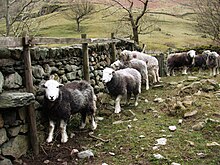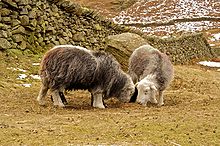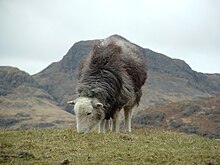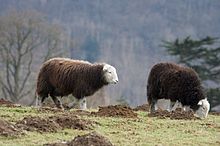Herdwick
Herdwick is a breed of sheep that is kept almost exclusively in the English Lake District . It is one of the many ancient British land races that are specially adapted to the harsh conditions of their region of origin. The breed is kept comparatively rarely today.
The history of this breed of sheep is linked, among other things, to the English children's book author Beatrix Potter , who established herself as a breeder of Herdwicks in the Lake District at the beginning of the 20th century , won numerous prizes with her sheep and was elected president of the breed association for this breed in 1943. Potter bequeathed her 17 farms in the Lake District to the National Trust in 1943, which she had acquired with the proceeds of her children's books and stipulated in her will that Herdwick sheep must be kept on the 16 square kilometers of land that belonged to these farms. The National Trust is now the Lake District's largest landowner. He owns 25,000 Herdwick sheep that are looked after by National Trust tenants. The Rare Breeds Survival Trust , which has the breed on its watch list, is also committed to preserving the breed .
Appearance
The Herdwick is a medium-sized sheep whose wool color ranges from light to dark gray to blue-gray in adult animals. Newly born lambs are initially gray to black. Annual Herdwicks have a dark brown wool that brightens to light to dark gray in the further years of life. The legs are covered with wool up to the front knee or ankle joint, the color of the strikingly stocky legs is white. The head is ram-shaped and should also be white or light gray. Black features on the head or legs are inconsistent with the breed standard. Bucks have horns that grow in a snail shape and have a sloping back line. In the case of bucks, the wool on the neck should also be extended like a mane. In contrast to the male goats, females are always polled. As a rule, ewes only give birth to one lamb born in April. Due to the harsh weather conditions, a large number of lambs often do not survive their first few months of life.
Buck reach a height at the withers of 75 centimeters and weigh between 75 and 90 kilograms. The females reach a height at the withers of 70 centimeters and weigh between 60 and 65 kilograms.
The wool output is between 1.5 and 2.5 kilograms per year. The wool is very coarse and is used almost exclusively to make carpets. Today it only plays a subordinate role in keeping the sheep, as shearing the sheep is hardly worthwhile due to the low wool prices. Herdwicks, which have a tasty meat, are mainly used today for landscaping.
properties
Location loyalty and robustness
Herdwicks are considered to be extremely hardy and frugal sheep and are able to cope with the difficult weather conditions of the rainy Lake District. Philip Walling even calls them the toughest breed in Great Britain in his book Counting Sheep , but calls them only a semi-domesticated breed. They are able to find sufficient food in the pastures in the hills and mountains of the Lake District during the winter months. Herdwicks also get by on extremely barren pastures and are usually not fed in the winter months either. There are individual reports of Herdwicks who were snowed in over a period of weeks and although they would have eaten their own wool out of hunger, they recovered completely from this time of need.
Herdwicks are also extremely faithful to their location, a key feature of the rolling Lake District landscape, where pastures are mostly limited by low stone walls. Walling points out that due to the poor pasture, the sheep grow slowly and females can often only be mated in their third year of life. It is therefore typical to find flocks of sheep in the hills of the Lake District, where three or four generations of sheep graze together. Herdwicks develop a pronounced instinct to return to the pastures where they grew up. Walling reports on Herdwick ewes that were sold to other farms at the cattle auctions in autumn, but returned to their home pastures in spring. They found their way back to their original pastures over a distance of forty to fifty miles. Walling goes on to say that he knows only a few breeds of sheep that are comparable in a position to recognize weaknesses in the fencing of their pasture and to take advantage of this.
flesh
Herdwick sheep meat is considered extremely delicate. Queen Elizabeth has already served meat of this breed at official banquets . Before mutton, i.e. the meat of castrated ram, went out of fashion, the meat of this breed was particularly valued. In traditional Herdwick herds, a larger number of castrated males always ran with them. They were sold as slaughter cattle at the earliest when they were at least three years old. Characteristic for the meat of such mutton is a game taste, which is due to the herb-rich pasture.
The British heir to the throne, Prince Charles, is one of the people who promote the consumption of Herdwick mutton. He founded the Mutton Renaissance Campaign in 2004 with the aim of making mutton a common meat in British cuisine again and thereby improving the income situation of the farmers who keep Herdwicks. Herdwicks mutton is sold at Borough Market , the oldest food market in London , among other places .
Breeding history
The origin of this breed of sheep is not known. The vernacular claims that Herdwick came to Great Britain after a shipwreck and is fond of referring to the Spanish Armada , which was badly damaged by storms in an attempt to invade the British Isles in 1588. The vernacular also claims the same thing about the Portland sheep and the Jacob sheep , both of which, however, have properties that make the origin of the respective breed in the Mediterranean area not unlikely. On the other hand, there is no traditional breed in Spain that matches the Herdwick.
The word Herdwick is certainly derived from Herdwyke , an Old Norse word for sheep pasture and Herdwick is believed to have been used to refer to all sheep breeds that grazed in the hills of the Lake District. Herdwicks are said to be genetically close to the Nordic short-tailed sheep . However, Herdwicks are not short-tailed, as is typical of these Nordic breeds. Walling thinks it is most likely that Herdwick is a cross between sheep that Vikings brought to the British Isles in the ninth and tenth centuries and those that were already kept in Cumbria .
A breeding cooperative for this breed was founded in 1844 and from 1855 animals were shown at breeding exhibitions. A breeding community followed in 1899 and the Herdwick sheep has been recognized as a breed since 1916. The breeding association has operated under the name Herdwick Sheep Breeders' Association since 1916 and people from the National Trust were involved when it was founded .
Beatrix Potter and the Herdwick
Beatrix Potter (1866–1943), who grew up in London, is one of the determined supporters of this breed. For a long time Potter led the conventional life of an upper middle class woman and lived in her wealthy parents' house until she was three years old, but had her own financial means thanks to her successful children's books, including The Story of Peter Hase . At the age of 39, against the determined opposition of her parents, she got engaged to her publisher Norman Warne, who died of leukemia shortly after the engagement . For Potter this stroke of fate was the impetus to buy Hill Top Farm in the Lake District, where her family had spent the summer months in their youth, which she began to run with the help of a land manager. Your steward bought the first small herd of Herdwick ewes in 1906, the year Potter bought the farm.
Potter acquired more and more land and several homesteads in the Lake District in the following years, which she let mostly by tenants. Hill Top Farm, on the other hand, remained the agricultural farm that she ran on her own and on which a herd of Herdwick ewes was always kept. Potter was aware that in the aftermath of World War I, many farmers in the area had gotten into financial trouble and not only were logging their land but also selling their Herdwick herds, so there was a risk that these would become typical of the Lake District Race would disappear. She was well acquainted with some of the people in the administration of the National Trust and was therefore well aware of both the qualities of this breed of sheep and its importance to the region. As early as 1919 Potter had regularly sent some of her Herdwicks to livestock exhibitions, but always remained without a price tag. According to their land manager, this was because Hill Top Farm did not provide the right conditions for Herdwicks - the farm had too rich soil for the breed, which thrived better in poor pastures. In 1923, Potter purposely bought Troutbeck Park Farm, high in the hills of the Lake District, with the express intention of rebuilding this rundown farm and establishing a Herdwick herd of 1,100 animals. At the time of purchase, Potter stipulated that this farm should be transferred to the National Trust when she died. In 1927, 1,000 sheep were grazing on Troutbeck Park Farm.
By 1924, Potter had become one of the few female members of the Herdwick Sheep Breeders' Association. Potter, who preferred to wear tweed costumes made from the wool of her sheep and, despite her wealth, mostly walked around in wooden shoes, was initially reputed by her fellow breeders to be just an eccentric hobby breeder with a sentimental love for this breed. According to Potter biographer Linda Lear, however, her colleagues underestimated how closely Potter, who was known for her detailed animal stories, could observe and what excellent knowledge of anatomy she possessed. She was very capable of judging the build and wool of a sheep. In 1927, Potter bought the Herdwick ram Cowie at the cattle auction, which had won awards for four years in a row at the Eskdale cattle show . In the same year, lambs from herds owned by Potter won awards at livestock shows for the first time. Together with her estate manager Tom Storey, she started a targeted breeding and exhibition program. In 1929, her ewes won first prizes at all major livestock shows in Keswick , Cockermouth , Ennerdale , Loweswater and Eskdale. She repeated this success the next year and also won the award for the best ewe in the Lake District. Her expertise gradually found recognition: in 1935 she was elected chairman of the Keswick Agricultural Show and from then on she was a regular judge at the exhibitions. In March 1943, the members of the breeding association elected Potter as president. However, Potter passed away before she could take office. She left the National Trust the 16 square kilometers of land she had acquired over the years in the region and specifically stipulated that Herdwicks were to be kept on it.
literature
- Linda Lear: Beatrix Potter - The extraordinary life of a Victorian genius. Penguin Books, London 2007, ISBN 978-0-14-100310-8 .
- Hans Hinrich Sambraus: Rare farm animals: 240 endangered breeds from all over the world. Eugen Ulmer Verlag, Stuttgart 2011, ISBN 978-3-8001-9527-5
- Philip Walling: Counting Sheep - A Celebration of the Pastoral Heritage of Britain . Profile Books, London 2014, ISBN 978-1-84765-803-6 .
Web links
Single receipts
- ^ Walling: Counting Sheep . P. 172.
- ^ Walling: Counting Sheep . P. 160.
- ↑ a b UK Breeding Association website, Racial Characteristics , accessed July 12, 2015
- ↑ a b Walling: Counting Sheep . P. 159.
- ↑ a b c Sambraus: Seltene Nutztiere , p. 101
- ^ Walling: Counting Sheep . P. 157.
- ↑ a b c Walling: Counting Sheep . P. 162.
- ↑ Linda Lear: Beatrix Potter , 2007, p. 319
- ^ Website of the Zuchtverband , accessed on July 12, 2015
- ↑ a b Walling: Counting Sheep . P. 158.
- ↑ a b c Walling: Counting Sheep . P. 174.
- ^ Walling: Counting Sheep . P. 13.
- ↑ http://www.bpotter.com/Beatrix.aspx
- ↑ http://beatrixpottersociety.org.uk/about-beatrix/
- ↑ Linda Lear: Beatrix Potter , 2007, p. 217
- ↑ Linda Lear: Beatrix Potter , 2007, p. 328.
- ↑ Linda Lear: Beatrix Potter , 2007, p. 317
- ↑ Linda Lear: Beatrix Potter , 2007, p. 327
- ↑ Linda Lear: Beatrix Potter , 2007, p. 334
- ↑ Linda Lear: Beatrix Potter , 2007, p. 436








